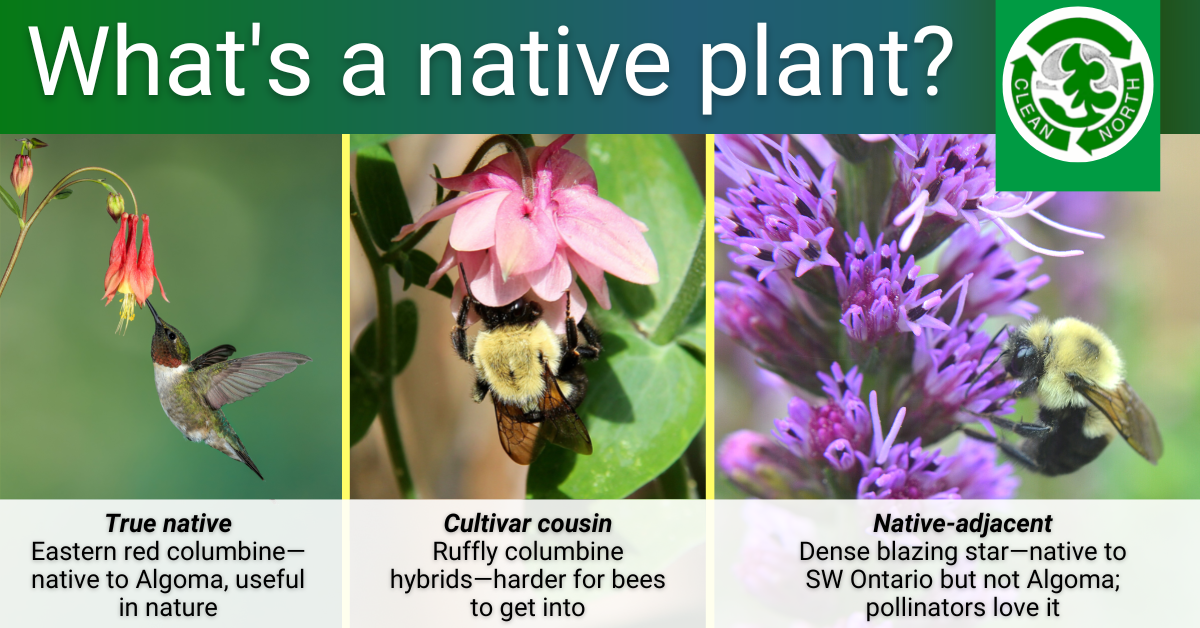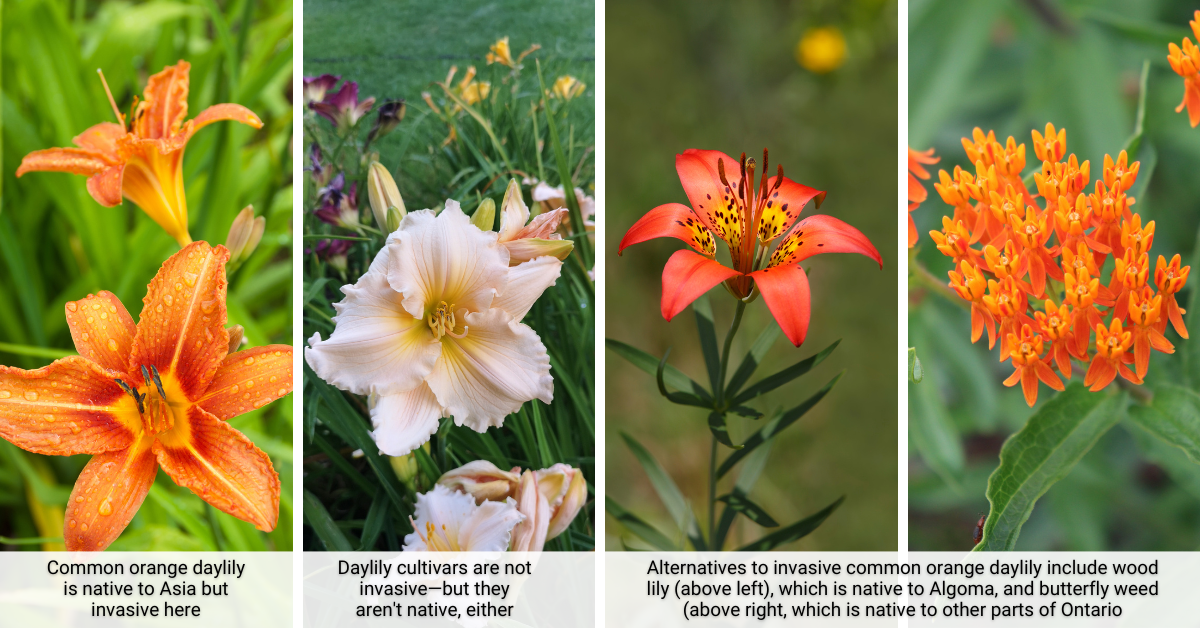
So you’ve decided you want to grow native plants. Maybe you are getting rid of invasive plant species and are embracing natives as alternatives that help our native pollinators, birds, and other wildlife (check out our Sault/Algoma Grow Me Instead Guide). The first step? Deciding what native plants to grow. And wow, this is more complicated than you might think.
First, some definitions…
Native plant: Grows naturally in our area without humans introducing it. Native plants have evolved in and are adapted to our area’s growing conditions. They support our native pollinators, birds, and other wildlife. For example: White trillium (Trillium grandiflorum) is native to Sault Ste. Marie/Algoma District (and to much of northeastern North America) and plays an important role in our ecosystems.
Non-native plant: One that does not grow naturally in our area but was introduced by humans. Non-native plants can be benign or invasive:
- Benign non-native: They do not cause harm to ecosystems, the economy, or people. For example, hostas are non-native and are less useful to our native pollinators, birds, and other wildlife. However, they are not considered harmful.
- Invasive non-native: These cause harm to ecosystems, the economy, and/or people. Example: Japanese knotweed is a non-native plant that can take over natural areas, cause harm to our pollinators, birds, and other wildlife, damage pavement and structures, and be costly to remove.
Cultivar: A plant bred by humans for desirable features like flower colour, fragrance, disease resistance, or hardiness. For example, daylily Stella d’Oro is a cultivar of common orange daylily, which is native to Asia (FYI, common orange daylily is invasive here, but its cultivars are not).
Nativar: A cultivar developed from a native plant. For example, false sunflower Summer Nights (Heliopsis helianthoides var. scabra) is a nativar of false sunflower (Heliopsis helianthoides), which is native to much of North America. Nativars tend to be less useful to pollinators, birds, and other wildlife (although more useful than non-native plants and non-native cultivars).
Now, some recommendations…
To best mimic nature…
…and support our pollinators, birds, and other wildlife, choose native species historically present in Algoma District and try to source plants from local populations or grown from local seed.
Local seed comes from a population of a given plant that is growing in our area and is more likely to be genetically adapted to our conditions. For example, seed from eastern red columbine (Aquilegia canadensis) growing in our area is likely to be better adapted to our growing conditions than seed from plants growing in the Niagara area.
Having said that, here in the Sault/Algoma, we are not exactly swimming in suppliers of historically native plants grown from local seed sources. If you are lucky, you may have a camp with native plants or know someone with rural property who could supply you with native plants or seeds. Read our blog post on how to collect seed.
We are aware of two northeastern Ontario businesses, The Superior Gardener here in Sault Ste. Marie and Northern Wildflowers in Lively, that sell seed for at least some species native to northeastern Ontario.
When choosing native plant species, consider growing conditions, too. Choosing a shade-loving species for a hot, sunny location or moving an acid-loving plant from your camp to your more alkaline yard could lead to disappointment.
The next-best option to local natives/seed?
- Source historically native plants/seed from native plant companies in other parts of Ontario (check out this list from Halton Master Gardeners). .
- After that, choose seed from other parts of Canada (you can also order plants but shipping them long distance can be tricky and could spread pests to new parts of Canada).
- Avoid ordering seeds/plants from other countries, especially from individuals or Etsy shops. There’s a major risk of getting seeds that are not viable or not the species you ordered—or even seeds for an invasive species. And buying internationally bypasses the checks and balances designed to prevent new plant pests/diseases from entering Canada.
- IMPORTANT: Be wary of seed packets marked “wildflower mix.” Many contain seeds for non-native or even invasive species. Always read which species are included and google them to determine if they are native, non-native, or invasive.
Keep in mind that most native plant seeds need 30-90 days of moist cold treatment before they will germinate. Check out our post on growing native plants through winter sowing in containers.
What about local garden centres?
You can find native plants and seeds at local garden centres, but be careful. Garden centre staff, especially those working in big box stores, aren’t always aware of what’s native to Algoma and what’s not. In fact, many garden centres still sell invasive species like goutweed, periwinkle, yellow archangel, lily of the valley, and Japanese barberry.
“Must I grow only plants native to our area?”
If you want to have a beautiful garden and help pollinators but are ok with plants that did not historically grow in the Sault/Algoma, that opens up your options. For example, dense blazing star’s historic range in Ontario is limited to a small area of southwestern Ontario. But it’s pretty, bees love it, and it does well in gardens here.
In addition, some of our native plants have cousins from other parts of North America are sold to us as native plants. Pink turtlehead species, for example, are not native to northern Ontario but do well in local gardens and are popular with bees. But consider planting our native white turtlehead (Chelone glabra) in addition to or instead of the pink ones.
What about nativars?
They’re not bad…just often not as good as their wild cousins. For example, super-ruffly columbine nativars are tougher for bees to get into to extract pollen.
It’s ok to plant nativars, just remember your objectives. If you are truly committed to helping protect nature, choose more true natives than nativars.
Watch out for invasive species!

It’s not rare for gardeners to end up with a non-native or even invasive species without realizing it. So before you buy, make sure the species you are considering align with your objectives, are the species you think they are, and are actually native to Algoma or at least Ontario.
Check out our list of invasive plants in Ontario
In summary
- Understand these terms: native, non-native, invasive, cultivar, nativar.
- To mimic nature as best as possible, choose species native to our area grown from seed from our area.
- If you have more flexible objectives, prioritize species and seeds from elsewhere in Ontario, which will still likely support at least some of our pollinators, birds, and other wildlife.
- Match each species to the intended site (soil type/level of moisture, light conditions, drainage, drought tolerance, etc.).
- Verify, verify, verify that each species you’re interested in is actually native to our area or at least Ontario and rule out invasives.
Got questions about growing native plants?
Email us at info@cleannorth.org.





2 Replies to “Growing native plants: Not as simple as you might think”
Comments are closed.